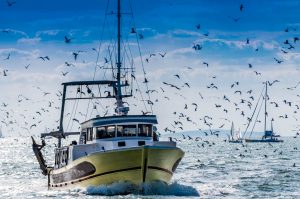Under the 1994 U.N. Convention on the Law of the Sea (UNCLOS), the high seas constitute the waters that lie beyond the 200-mile exclusive economic zone of any littoral country. While UNCLOS established principles mainly related to freedom of navigation, it lacks detailed provisions on environmental conservation and stewardship of the high seas. The Treaty on Biodiversity Beyond National Jurisdiction (BBNJ) — which is the third internationally binding implementing agreement under UNCLOS — is arguably the most significant multilateral environmental convention since the Paris Climate Agreement of 2015.
According to a U.N. Conference on Trade and Development (UNCTAD) report, ocean-based industries were valued at a total of $2.5 trillion annually (based on 2018 data), while more than estimated 3 billion people worldwide depend on oceans for their livelihood. Undeniably, the open ocean also possesses a wealth of biodiversity and is a provider of crucial ecosystem services, including living resources such as seafood, which many littoral states depend on for food consumption and export.
Despite existing legislation, fisheries in the high seas continue to remain vulnerable to widespread illegal, unreported, and unregulated (IUU) fishing. Thirty-five percent of the fish stocks are fully exploited in the Western Indian Ocean, while IUU activities have also decimated fish stocks in the South China Sea and ravaged the Coral Triangle. While deterioration of ocean health has been traditionally attributed to fisheries, tourism, and maritime transport, other technology-enabled activities, such as marine renewable energy and biotechnology exploits, have also led to rapid depletion of marine resources.
Notably, environmental NGOs have increasingly lobbied against excessive anthropogenic activities, such as deep-sea mining, that could disrupt marine life and habitats, resulting in irreversible biodiversity loss. Coupled with climate stressors such as ocean warming, acidification, deoxygenation, and marine heatwaves, the need for collective action over ocean resilience has never been more urgent as a shared vision for the “ocean commons” gather pace. Unfortunately, only roughly 7 percent of the world’s ocean today are protected.
The BBNJ Treaty addresses this gap by designating Marine Protected Areas (MPAs) in the high seas, with a global target of protecting 30 percent of the world’s oceans by 2030 (30×30) – a pledge committed by countries under the U.N.’s Global Biodiversity Framework in December 2022. Signatory countries will have to abide by these MPAs, which will delineate the extent of fishing activity, as well as shipping lanes and commercial exploration activities.
Within the Indo-Pacific region, the Association of Southeast Asian Nations (ASEAN) and Asia-Pacific Economic Cooperation (APEC) member states have all initiated resource cooperation campaigns aimed at developing the blue economy. For instance, at the 2017 Jakarta Declaration on Blue Economy, Indonesia proposed the principles of developing marine and fishing industries to boost regional economic development sustainably. In the 2019 Osaka G-20 Summit, Japan shared the “Osaka Blue Ocean Vision” which called for a reduction in marine pollution of plastic litter in the sea to zero by 2050, while ASEAN countries such as Malaysia and Philippines have created Marine Protected Areas as part of their national biodiversity conservation strategies.
Upon ratification, the treaty will contribute significantly to international standards in ocean governance, which hitherto constitutes a patchwork of political institutions and legal standards, often with a narrow focus that is ineffective in managing the cumulative impacts of human activities. For instance, while many Indian Ocean countries claim to comply with fishery regulations, the governance regime in the region is undermined by a lack of an overarching authority providing clear and consistent standards, as well as capacity limitations on enforcement.
Throughout almost two decades of negotiations leading up to the BBNJ Treaty, countries had been locked in debates over various technicalities, including how to distribute potential profits gained from marine resources in a “fair and equitable” manner and where/how marine protected areas will be established. Once ratified by signatory parties, it will establish a new international framework for the high seas with its own secretariat, under the governance of an intergovernmental conference of parties and with the support of a new scientific and technical committee.
Despite the passing of a landmark deal on the high seas signed by all member states of the U.N., it will only come into effect when at least 60 countries have passed the legislation in their own countries. Signatory countries are required to initiate the ratification of the treaty based on their own domestic legal procedures, which can be onerous depending on national requirements and circumstances. For comparison, UNCLOS took 12 years to enter into force, while the 30 ratifications required by the U.N. Fish Stocks Agreement took six years.
Building awareness and political will across multiple levels (e.g. national, regional, and global) is imperative for expediting the ratification process. Additionally, civil society and epistemic communities can provide legal, scientific, and technical assistance through track II and III dialogues and initiatives.
The associated financial mechanisms for implementing the treaty, to which the EU has already pledged $42 million, will also be instrumental in keeping the 30×30 vision alive. Initial funding could also be available through public-private partnership models providing grants and blended finance; a case in point would be the Global Environment Facility, which spun off from the Global Biodiversity Framework. Meanwhile, other existing or past international bodies such as the U.N. Food and Agriculture Organization (FAO), which actively endorsed the Port State Measures Agreement (PSMA), could catalyze blue economy transitions in specific sectors and/or regions.
In conclusion, many challenges loom on the horizon. Signatory parties will need to adopt an inclusive approach in consulting various stakeholders to formulate a comprehensive action plan that ensures equitable sharing of resources, with sufficient safeguards and recourse available to the small island developing states. Unless countries remain committed to enforce adequate oversight and protection of the oceans that they depend on, it would be inconceivable for their blue economies to stay afloat.

































